An online marketplace benefits businesses and customers. It keeps businesses visible 24/7/365 and provides a safe shopping space for customers. Currently, most shopping is done virtually.
Businesses win from platforms where they:
An online marketplace benefits businesses and customers. It keeps businesses visible 24/7/365 and provides a safe shopping space for customers. Currently, most shopping is done virtually.
Businesses win from platforms where they:
Buying habits and preferences have fundamentally changed since the pandemic crisis. Online is safer. Although restrictions related to COVID-19 are significantly softer in 2023, users have bought into all the convenience of online shopping.
That is why demands for marketplace development have skyrocketed. Online marketplaces give customers a safe place to wander virtually and buy safely.\
Is designing a marketplace difficult? Yes. Be wise. Follow in the footsteps of today’s online marketing giants. They started by launching a Minimum Viable Product (MVP).
Many of today’s giants, such as eBay, Kickstarter, or Etsy, began their successful business journeys by first opting for marketplace MVP development. They heeded valuable user feedback, improving and fine-tuning their products to meet customer expectations. They are now billion-dollar businesses.
Remember! Сreating a marketplace is not difficult for experts who have already designed and developed it. They have the necessary roadmap. They have the right expertise.
Now let’s focus on the technical side of the question “How to build a marketplace website MVP?”
Developing an MVP for an online marketplace includes six steps:
For optimal success, be wise and include all six.
Some steps can be done simultaneously when using Agile development.
Now, let’s unwrap each step on how to create an online marketplace:
At the discovery stage, there is laser focus on project goals and ways to achieve them. Your chosen team estimates the feasibility of the project.
The essential purpose of the discovery is to conduct market research and provide the client with requirements wrapped in technical documentation.
Also, the team determines the industry gaps and visualizes a concept of your marketplace that will fill the gaps.
The product owner and development team plan a detailed roadmap during the mapping stage. It allows stakeholders to estimate the entire project’s timeline.
The point is to define what must be done (coding, testing, etc.), when, and by whom. When the development path is ready, work on the project starts.
The design stage is done separately but with both UI and UX designers working in sync. UI designers prepare layouts of the app screens and different visual elements (e.g., icons, buttons, etc.).
A UX designer is needed when user flow is unclear to ensure users intuitively understand how an MVP marketplace works.
The code development and testing stage is a series of iterations during the progress of the code. Software developers write source code for present and future functionality.
Software engineers work simultaneously on different system parts to make rapid progress on the project. When a source code section is complete, QA engineers check it and send it back for improvement if required.
Also, performance testing becomes crucial when rapid user-base growth is anticipated. It ensures software can withstand user influx.
A reliable tech vendor provides your online marketplace MVP with three essential outcomes:
The development team works continuously on one sprint after another to deliver the software. At the beginning of each sprint, the team sends the product owner a plan for estimated sprint activities. At the end of each sprint, the product owner gains access to the finished part of the functionality and a detailed work report completed.
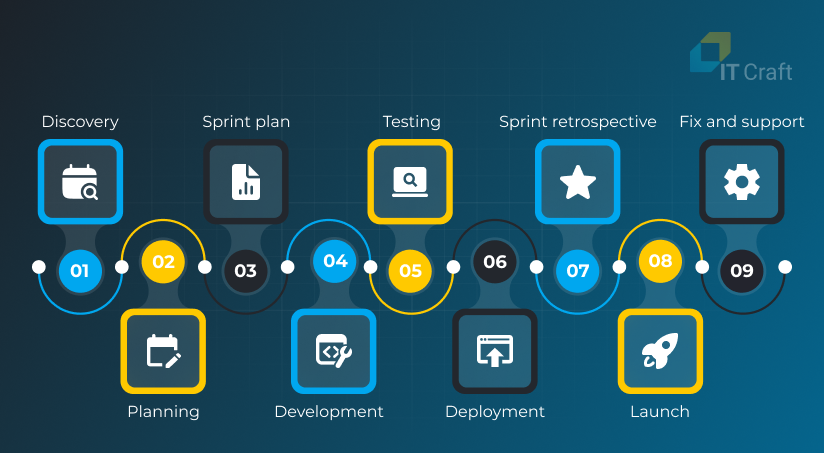
This is where an important project stage starts. The development team supervises software, ensuring no downtime, bugs, or flaws spoil user experience. The team provides needed system updates and enhances security.
Also, once the MVP is available, it is vital to focus on user feedback, analyze it, and adjust to your MVP. Assume the best-fit way to meet user expectations, introduce a new feature, or change an existing one. Repeat the process with every newly added feature until an optimal solution is ready.
There are three main options for startups when building an MVP for an online marketplace.
Startups can:
The best choice depends on a startup’s managerial and engineering background and available budget range. Still, if there is little-to-no experience, choosing software development services for startups with an experienced software development company seems wise. Startups benefit from an established workflow and accumulated expertise. Faster to the finish line. Fewer headaches.
US Car Trader is an online marketplace providing access to 6.5 million cars.
Industries: E-commerce
Duration: 2020 – ongoing
Technologies: Docker, AWS, Symphony, React.js, Next.js, SCSS, PHP, MySQL, Redis.
Project background: Build a turnkey solution where users can purchase a US car at no risk and deliver it to the EU. The company covers all steps, such as car examination, purchase, and delivery to the end customer. The software calculates optimum logistics from the seller to the purchaser. Purchasers see all purchase-related costs upfront.
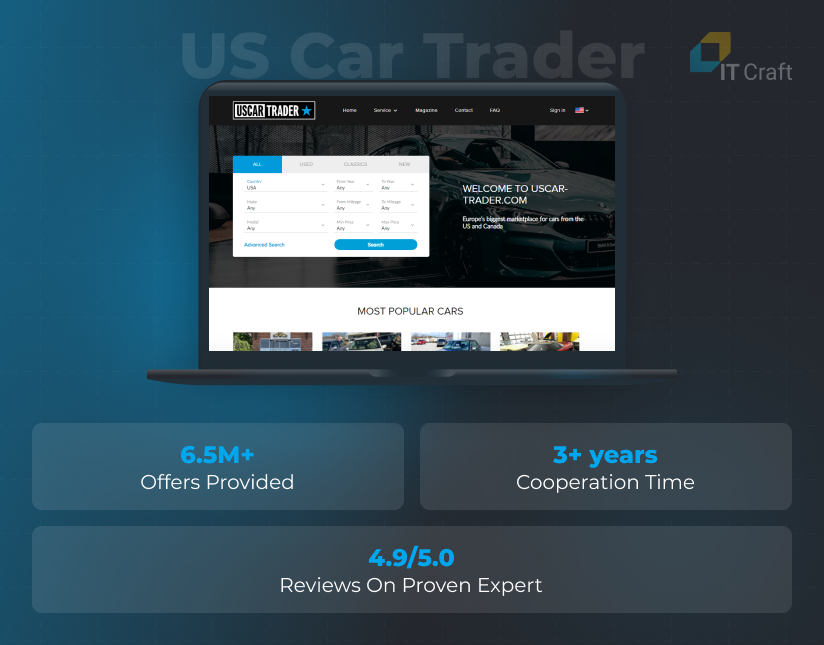
Adorama is the global marketplace for photo, video, pro-audio equipment, electronics, and more.
Industries: E-commerce
Duration: 2007 – 2019
Technologies: Castle Windsor, JavaScript, MS SQL, IIS, JQuery, ASP.NET, ASP MVC, .NET Framework, C#
Project background: Adorama’s online presence started with a simple, internally built system. The company needed to transition to an e-commerce system to operate as a global online marketplace. IT Craft developed an efficient, reliable, scalable platform. The marketplace provides users with responsive design and the ability to find and buy equipment from a structured catalog.
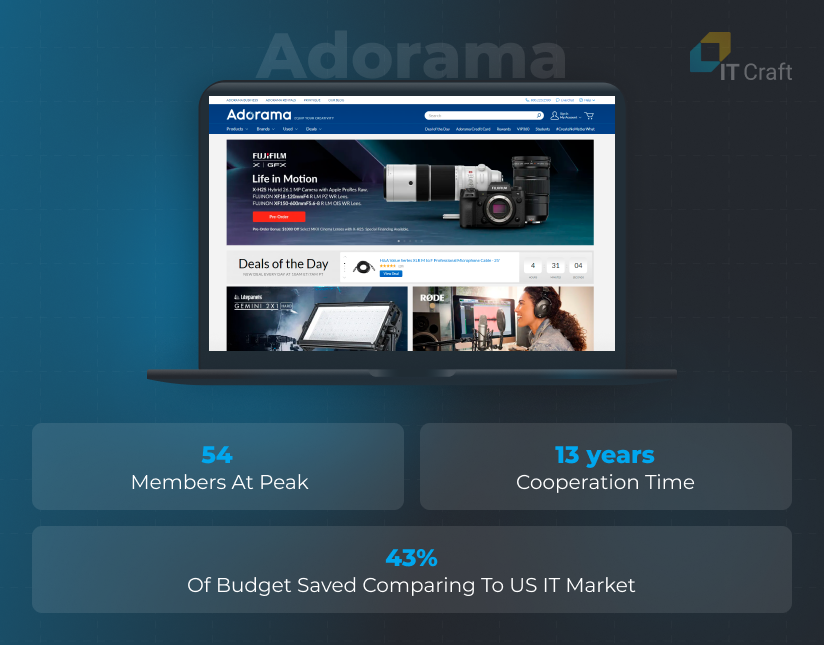
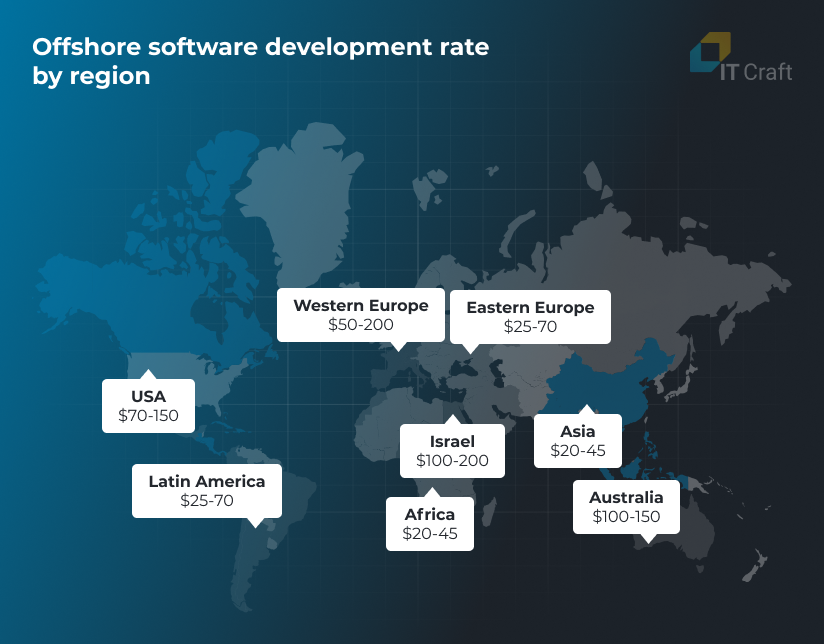
MVP pricing depends on several factors. The cost significantly fluctuates according to:
One of the most important factors that define the overall cost of startup development is your provider’s hourly rate. In the software development industry, the rates are different at times according to the geography of the tech vendor.
For example, in countries like the US, Australia, Western Europe, Israel, and UAE, MVP costs your business between $50 to $200+ per hour.
The same services in Latin America, Asia, and Africa will average costs from $20 to $50. Unfortunately, low rates often deliver poor product results, translating into budget drain and time waste.
Companies from Eastern and Central Europe offer their software development services from approximately $25 to $70. Optimum correlation between price and quality.
Considering numerous pricing factors, MVP cost swings accordingly. In practice, an online marketplace solution will cost you between $14,000 – $60,000, depending on app complexity and type of cooperation (in-house, onshore, offshore, nearshore.) Costs could skyrocket to $150,000 and higher if extensive work on the software back end is required.
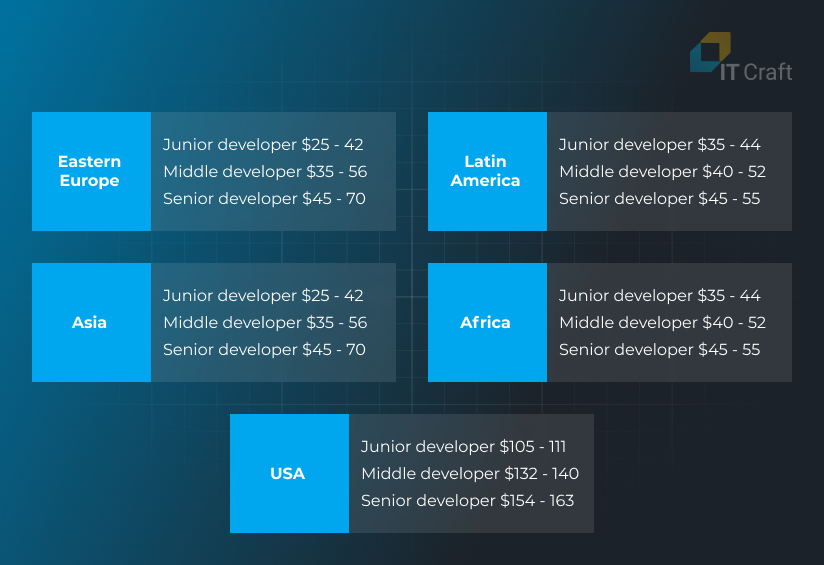
IT Craft has a solid background in delivering MVPs in mobile, web, and desktop products. For decades, we have helped 300+ projects turn their ideas into successful businesses and raise $100M+ in fundings.
Our BAs, QAs, PMs, engineers, and designers create testable prototypes allowing startups to enter markets fast. Processing feedback from real users of such an MVP indicates the gaps so startups can upgrade their products accordingly.
If you are considering launching your online marketplace MVP, IT Craft has you covered. Check out the following table for detail:
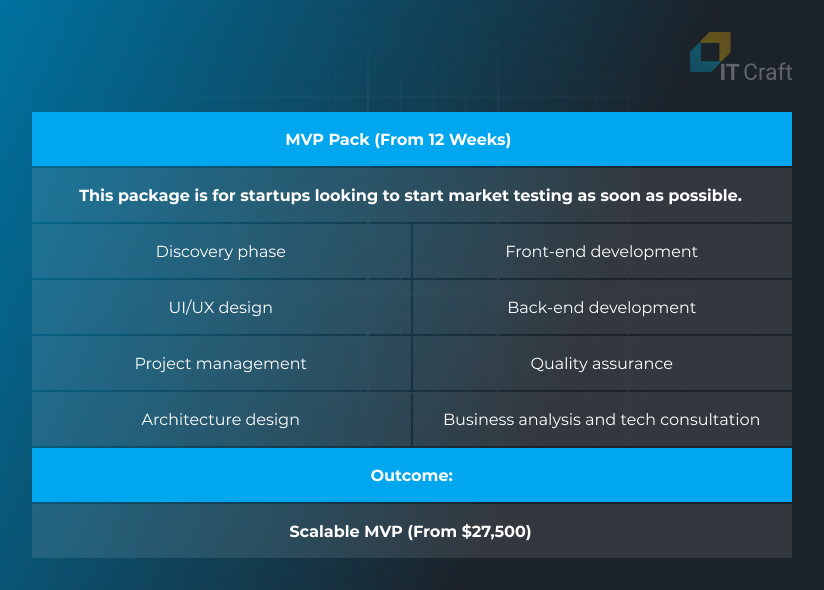
Now, let’s discover why adjusting the MVP concept is necessary when starting your marketplace and how you can benefit from it.
An MVP allows startups to validate their market ideas fast with minimal upfront investment.
Globally, there are hundreds of marketplaces. Users can buy almost anything. They choose the amount, payment option, and delivery terms.
Should you give up your idea of starting a new marketplace? No.
Find that special something your marketplace can do better than existing competitors do. This is where MVP development helps. An MVP tests the waters to find out what users prefer and want.
An MVP is a ready-to-use piece of software. It contains core features to help you find out if your business idea appeals to users and solves their perceived pains better than any other available solutions.
An MVP is a ready-to-use piece of software. It contains core features to help you find out if your business idea appeals to users and solves their perceived pains better than any other available solutions.
When starting MVP software development, your startup gets:
A marketplace minimal viable product is a practical way of discovering more about your avatar. Startups face this fact fast. They see which ideas work, don’t, and need improvement.
Benefits of launching an MVP include:
Reducing all ideas to the core lets startups quickly present their software. Startups get feedback from early adopters fast and present a new version of their product quickly.
The most accurate feedback you can collect — actual users of your idea. Run your MVP and see what makes people fascinated by your product. The best way to engage – is to share your business thoughts. MVP is the perfect way to do so.
An MVP only contains necessary functionality. Nothing more. Nothing extra, nothing fancy. This keeps development costs in line and results in robust software.
It might turn out that part of the software should be redeveloped to cater to actual needs. As long as an MVP is simple, making changes is relatively easy and affordable.
MVP development keeps startups’ cost low helping startups “stay in the game.”
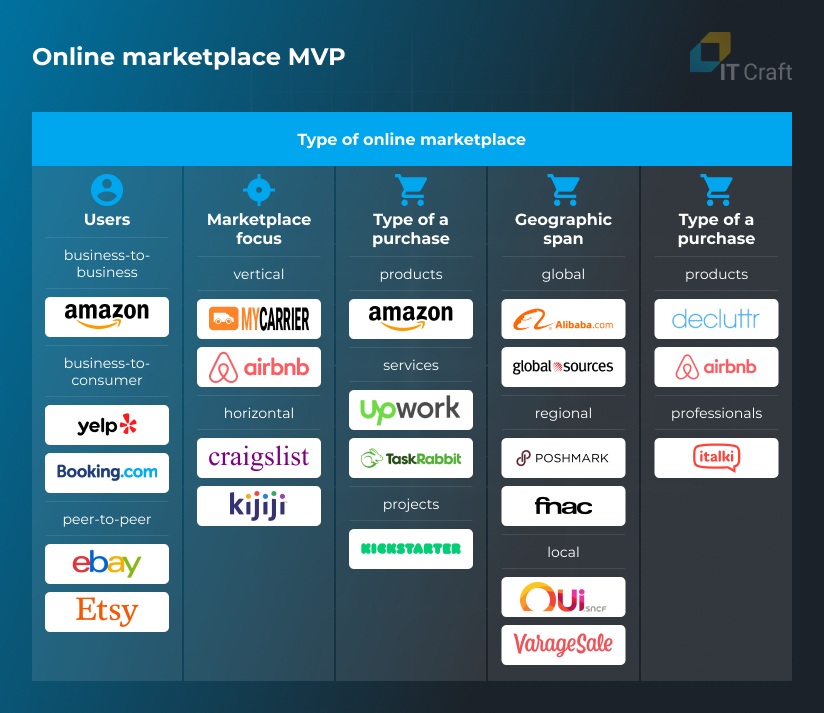
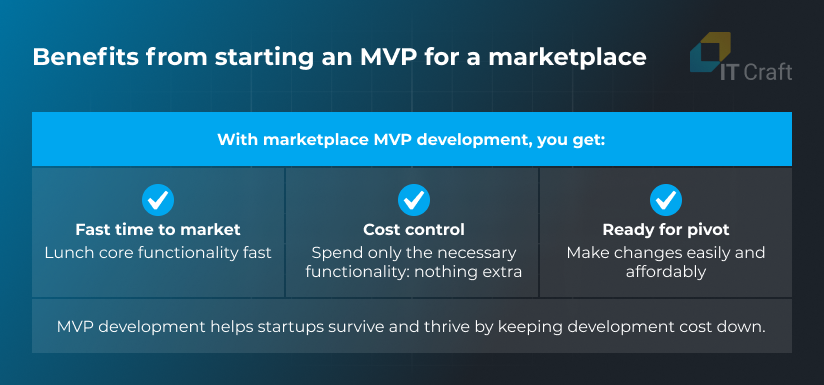
All successful MVPs for marketplaces contain unique, killer features that differentiate them from their competitors.
As long as they serve the same purpose—providing a safe space where customers meet sellers—startups need the same or similar functionality when they build an MVP marketplace.
All marketplace MVPs functionality is divided into three groups: two primary user groups— buyers and sellers—plus administrators to supervise system activities and help both users when needed.
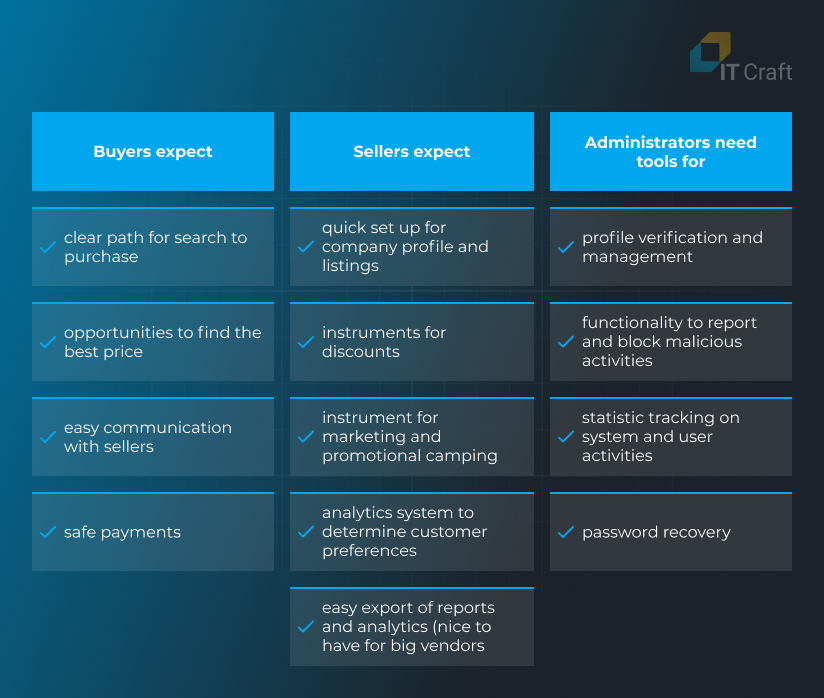
An MVP for an online marketplace needs the following functionality:
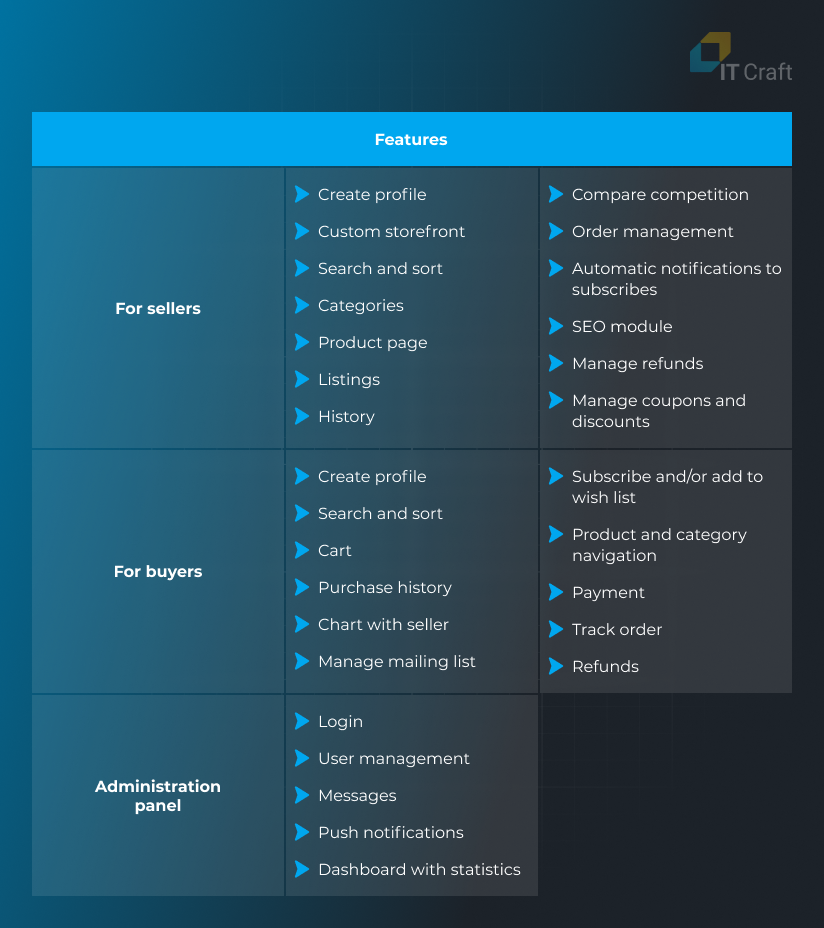
Remember a mobile-first approach for a successful MVP marketplace. Users prefer online shopping from their smartphones. Ensure they can do it without stress.
Further reading: What Does Marketplace Website Development Cost You?
Service promotion must start long before MVP development.
There are free and paid methods. Startups use both.
What about measuring effectiveness? Unfortunately, your minimal viable product success metrics are not set in stone.
Still, the following metrics can display the signs that strategy must be reconsidered:
It is crucial to decide on a pricing strategy in advance.
Pricing options can be divided into two main groups:
The main sources of revenue for marketplaces.
Still, the following metrics can display the signs that strategy must be reconsidered:
Rates and their combinations can vary for different user groups (e.g., no membership fees and higher transactions for small businesses vs. membership fees and lower transactions for large businesses). This creates a balance for everyone.
Online marketplaces are businesses at scale. They encourage users to be active and sell more through the platform. Fees and commissions are effective instruments for client retention.
Now is the best time to start working on an MVP. Establishing a successful, sustainable online marketplace takes time. The sooner you determine what you want, the faster you get started.
A series of tests usually follow an MVP to determine what users need. The result of the first attempt might not be as mind-boggling as anticipated. Listen and learn from user feedback, correct your assumptions—then start again.
Think in advance about these two crucial points:
A business survives only when it has a stable base of paying clients. Seriously consider why people would choose your service over any competitor. Also, consider monetization (premium features? ads and promotion? transaction fees?)
You can do it on your own. You can hire an in-house team or order single development activity from different freelancers. Or you can find an experienced, reliable software development company and benefit from an established, efficient, predictable workflow.
Over the past 20 years, IT Craft has been helping startups succeed—and succeed greatly.
IT Craft will also do it for you. Our company is an ideal partner for startups striving for a successful MVP marketplace launch.
Your marketplace is your project. And we know how to drive it fast, efficiently, and decently. IT Craft supports, maintains, operates, and uplifts businesses. Check out business experience from our clients and reviews of our company at the independent sources: Upwork, GoodFirms, and Clutch.
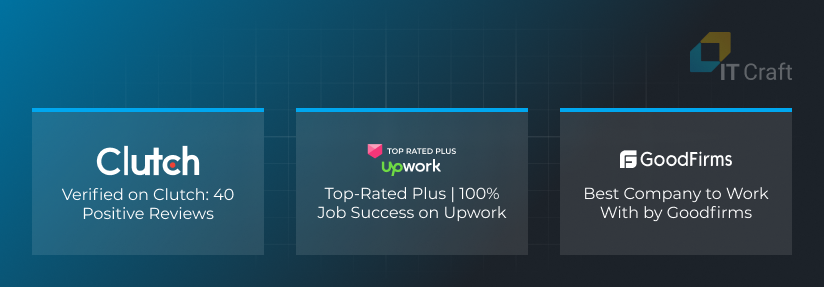
Our Benefits:
Development teams consist of experienced professionals who keep improving their skills. A special R&D department tries innovative technologies, ensuring your project is based on a relevant tech stack and a prolonged software life cycle possible.
Development teams have helped many startups launch MVPs for their marketplaces. They know where potential pitfalls occur and how to eliminate them. Developers and DevOps help optimize resource consumption, ensuring lower maintenance bills. Also, developers design flexible architecture to ensure scalability when the startup gets traction.
IT Craft has 300+ engineers of various specializations. Finding the right team who can take over the project is easy. The company estimates the scope of work and then discusses project details with its client. The IT Craft designated team starts working when they both sign the contract. No time wasted.
A dedicated project manager and a business development manager are responsible for a smooth workflow. They provide timely reports on all project activities. They always stay in touch with the client and respond swiftly within business hours to client’s questions.
Every project includes post-release guarantee support. Every marketplace startup enjoys 1 – 3 months of support when the same development team efficiently fixes bugs and flaws in their source code at no extra cost to the startup.
An online marketplace solution will cost you between $14,000 – $60,000, depending on app complexity and type of cooperation (in-house, onshore, offshore, nearshore.) Costs could skyrocket to $150,000 and higher when extensive work on the software back end is required.
Use the following steps to create a marketplace app:
Start with a prototype to see what your idea is worth. This can be a website or a landing page describing your future services and offering to subscribe and become an early tester.
Alternatively, start a crowdsourcing campaign on Kickstarter or a similar service.
To start an online marketplace business, take these action steps:
It depends on the project scope. Usually, a simple MVP takes 4 – 5 months of development. Bigger projects can take 9 – 12 months.